The Printing Machinery Market is estimated to be valued at USD 25.0 billion in 2025 and is projected to reach USD 39.6 billion by 2035, registering a compound annual growth rate (CAGR) of 4.7% over the forecast period.
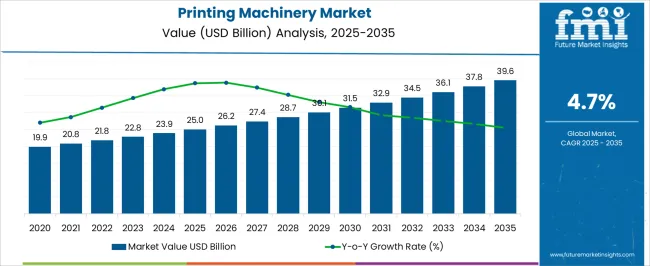
| Metric | Value |
|---|---|
| Printing Machinery Market Estimated Value in (2025 E) | USD 25.0 billion |
| Printing Machinery Market Forecast Value in (2035 F) | USD 39.6 billion |
| Forecast CAGR (2025 to 2035) | 4.7% |
The printing machinery market is experiencing robust momentum driven by technological advancements, expanding packaging demand, and increased customization requirements across multiple industries. Rising consumer preference for high quality, visually appealing printed materials has prompted investments in advanced printing solutions that offer precision and efficiency.
Digital integration, automation, and eco friendly inks are further reshaping the competitive landscape by enhancing operational productivity while aligning with sustainability goals. Growing e commerce penetration has accelerated demand for high volume, quick turnaround printing applications in packaging and labeling.
Regulatory emphasis on recyclable substrates and reduced waste generation is encouraging manufacturers to innovate in printing technologies tailored for diverse materials. With these drivers, the market outlook remains strong, supported by continuous adoption of digital enhancements and sustainable practices in both developed and emerging economies.
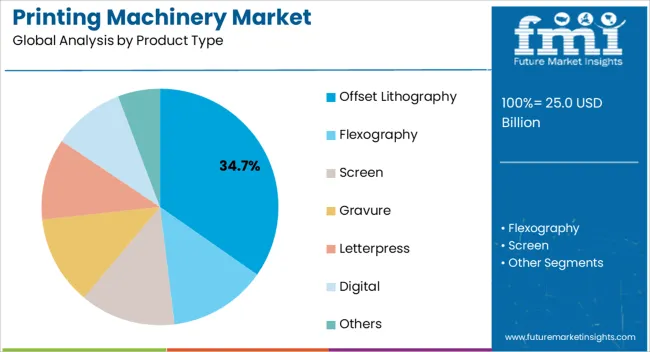
The offset lithography product type segment is projected to account for 34.70% of total revenue by 2025, making it a leading category in the market. Its dominance is attributed to its superior image quality, cost efficiency in high volume production, and ability to deliver consistent results across large print runs.
Offset lithography has been widely preferred for commercial printing applications due to its scalability and versatility across multiple formats. Continuous improvements in plate making technology and integration with digital prepress workflows have strengthened its operational efficiency.
As demand for high resolution and cost effective solutions persists, this product type maintains a strong presence in the global printing machinery market.
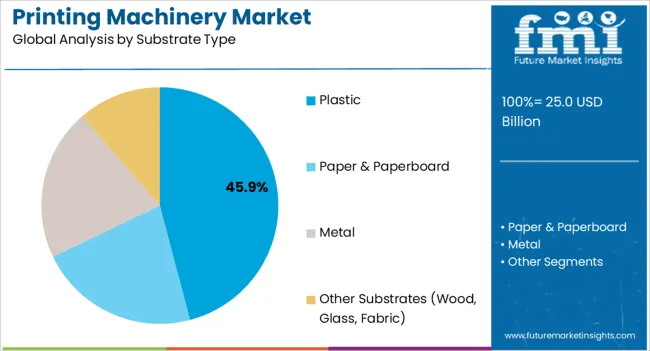
The plastic substrate type segment is expected to hold 45.90% of total revenue by 2025, positioning it as the most significant material choice. Its popularity is linked to its durability, flexibility, and ability to support vibrant color reproduction, making it highly suited for diverse printing applications.
Plastic substrates are widely used in packaging and labels, which demand resistance to moisture, chemicals, and physical wear. With consumer goods and food industries requiring high performance and visually appealing packaging, the adoption of plastic substrates has accelerated.
Additionally, advancements in recyclable plastics are driving further acceptance as industries focus on sustainable yet durable solutions, reinforcing plastic as the leading substrate in the printing machinery market.

The packaging and labels application segment is projected to capture 53.80% of total market revenue by 2025, establishing it as the dominant application category. This leadership is attributed to the rising need for brand differentiation, regulatory compliance in labeling, and consumer demand for informative and visually engaging packaging.
The growth of e commerce and retail has intensified the requirement for high quality, cost efficient printing machinery capable of handling large volumes. Packaging and labeling also benefit from innovations in digital and hybrid printing technologies that support variable data printing and customization.
These capabilities have made packaging and labels the central driver of printing machinery adoption, with sustained growth expected as industries increasingly prioritize brand visibility and sustainability.
Advantage over the usage of digital printers has increased exponentially because of its various advantages over the conventional printing technology. Digital printers are also preferred due to their capability of printing on a substrate. The trend of substrate printing on aluminum, glass, wood, etc. is projected to create an opportunity for non-label printing options in future.
Inks specifically supplied for digital printing presses allow converters and print service providers (PSPs) to cater to the high-impact packaging requirements of their clients. The convenience offered by digital presses over conventional presses is providing faster turnaround time. This has led to digital printing being widely accepted in the prime labels market.
The demand from packaging converters and consumer brands to tailor their marketing communications has led to growing opportunities for digital printing industry. In addition to this, it has also created vast prospects for digital ink manufacturers in the packaging market.
Opportunities for Printing Machinery Industry
The industry is filled with plenty of opportunities. For instance, technological advances in machinery are expected to elevate the market growth graph in the coming years. Intense competition in the market has led small and sizable print businesses to adopt modern developments in terms of software and machine features. Listed below are recent developments taking place in the industry:
Key Challenges Putting the Manufacturers at Guard
| Attributes | Details |
|---|---|
| Market Size 2020 | USD 18,818.3 million |
| Market Size 2025 | USD 21,790.7 million |
| Value CAGR (2020 to 2025) | 3.7% |
| Market Size 2025 | USD 22,814.9 million |
| Market Size 2035 | USD 38,572.8 million |
| Value CAGR (2025 to 2035) | 4.7% |
| Collective Value Share: Top 5 Companies (2025E) | 22.5% |
Increasing demand for sustainable substrates has spiked the revenue generation for the printing machinery industry worldwide. It is predicted to rise at 4.7% CAGR from 2025 to 2035 in comparison to the 3.7% CAGR registered during 2020 to 2025.
Variable data printing (VDP) has emerged as a marketing communication tool. It allows one to personalize packaging information to target a specific group audience or even an individual. In recent years, there has been a shift in the demand from conventional printing to variable data printing and personalized printing. Digital printing is economical as compared to traditional printing technologies.
Thus, companies can now print smaller qualities of packaging with variable information, allowing the possibility of innovative approaches to packaging solutions. Variable data printing has vested business opportunities in digital printing.
Flexographic printing technology is particularly driven by application in the packaging and labels market segment. Flexographic printing technology has been gaining market share from traditional technologies such as gravure and offset. End consumers for packaging and commercial printing applications are shifting towards offset printing processes.
Recent years have seen a spike in usage of Stock Keeping Units (SKUs) which are manufactured by barcode label printers. This variety of labels witnesses growth owing to an increase in the production of fake and counterfeit products and the robbery of valuables. They also provide the advantage of managing inventories for customers of barcode printers.
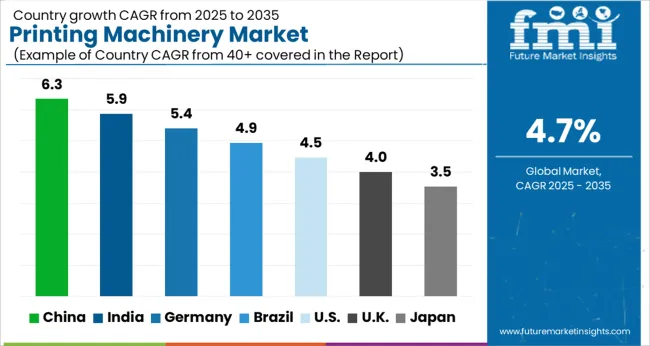
2025 Value Share Analysis of the Global Printing Machinery Industry
| Country/Region | Value Share (2025) |
|---|---|
| North America | 25.8% |
| Europe | 24.2% |
| The United States | 21.1% |
| Germany | 6.1% |
| Japan | 3.8% |
| Australia | 1.2% |
Value CAGR (2025 to 2035)
| Countries | CAGR (2025 to 2035) |
|---|---|
| The United Kingdom | 3.2% |
| China | 5.6% |
| India | 7.6% |
India is projected to be a significant shareholder of the Asia Pacific printing machinery market by the end of 2035. The country is projected to expand at 7.6% CAGR over the forecast period. The expansion and penetration of the manufacturing value-added industries are projected to present lucrative opportunities.
As printing machinery manufacturers to augment their revenue generation in India. Also, according to FMI, India has seen a steady increase in demand for sustainable packaging over the last decade.
The ever-increasing production of advertising, office stationery, books, labels, and packaging in India, has gradually risen the demand for printing machinery. The need for eco-friendly, biodegradable solutions has increased the growth of global printing machinery market.
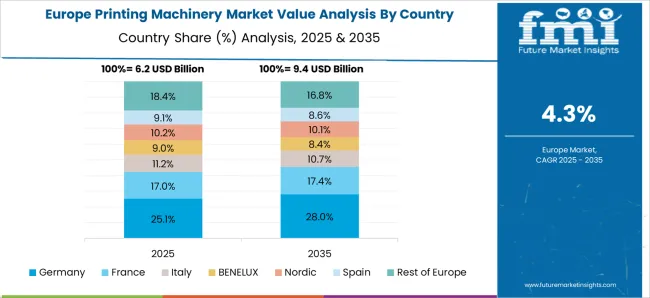
Germany is the leading manufacturer in the field of instruments, appliances, and parts in the European market. Subsequently, the demand for labeling in printing machinery in Europe is growing. Germany observed a market share of 6.1% in 2025.
Key players from Germany are mainly emphasizing manufacturing eco-friendly products with biodegradable properties while using paper & paperboard substrates. Therefore, Germany printing machinery industry is projected to increase by expansion and incremental opportunity of 1.2 times in the forecast period.
| Category | Product Type |
|---|---|
| Segment | Offset Lithography |
| Value Share in 2025 | 49.2% |
| Category | End Use |
|---|---|
| Segment | Packaging |
| Value Share in 2025 | 42.1% |
Paper & paperboard is widely used in applications such as commercial printing, books, newspaper & magazines, packaging, and labeling. This can be attributed to its favorable properties, such as durability, recycling, and convenience in packaging.
Across the globe, demand for paper & paperboard substrate has increased exponentially which has completely transformed the packaging industry. Due to various properties such as ease in storage and handling, ease in usage has mostly affected the use of paper and paperboard substrate. As a result, the usage of paper & paperboard substrate in printing machinery is projected to expand by 1.4 times by the end of 2035.
Packaging is projected to lead the end-use segment in the global printing machinery market. The segment held a market share of about 42.1% in the year 2025. Packaging is projected to continue to lead the end-user industry segment of the target market. Due to the high demand for applications such as packaging and labeling.
Publication and commercial segments are expected to show a respective incremental opportunity of USD 1,058.0 million in 2025. In emerging economies, the increase in government expenditure on manufacturing value-added industries has spiked in the last few years. It is expected that it’ll impact the packaging end-use segment by an expansion rate of 1.3 times its current market value.
Companies operating in the printing machinery market are aiming at expansions and strategic partnerships with other manufacturers. Such actions are aimed at expanding their product manufacturing capabilities, product portfolio, and global presence.
How can Manufacturers Expand in the Printing Machinery Market?
Manufacturers can scale their businesses by tapping into the robust demand for packaging. Packaging section is projected to result in high yields over the long term. The packaging industry is fuelled by the e-commerce sector, the growth of which became more pronounced post the pandemic.
Packaging is never going to go out of demand, as predicted by industry experts. This is why manufacturers of packaging are focusing on bringing into practice sustainable products. Moreover, processes to avoid or lessen the ramifications caused by non-biodegradable materials.
Dealers of printing machinery are noting the current changes and upgrading the printing machinery to work well with different substrates.
Growth opportunities are extremely lucrative in emerging nations like India and China. Manufacturers and suppliers of printing machinery can look out for growth prospects in these nations.
If producers want to reap exponential benefits, they must integrate their processes with new technology. By adopting new technologies like AI, Big Data, etc., and automating their processes, printing machinery engineers can cut down on expenditures. Needless to say, producers may enjoy a high-profit margin as a result.
By understanding the recent trends, manufacturers can greatly increase their surface area for success in the coming years.
| Attribute | Details |
|---|---|
| Forecast Period | 2025 to 2035 |
| Historical Data Available for | 2020 to 2025 |
| Market Analysis | USD million for Value, Units for Volume |
| Key Regions Covered | North America; Latin America; Europe; Japan; Asia Pacific; the Middle East & Africa |
| Key Countries Covered | The United States, Canada, Brazil, Germany, the United Kingdom, France, Italy, Spain, Russia, GCC Countries, China, Japan, South Korea, India, and Australia |
| Key Segments Covered | Product Type, Substrate Type, Application, End-use, and Region |
| Key Companies Profiled | Agfa-Gevaert NV; Oce NV; Bobst Group SA; Fujifilm Holdings Corporation; Heidelberger Druckmanschinen AG; HP Inc.; Koening & Bauer AG; Komori Corporation; Apex Machine Company Inc.; Officine Meccaniche Giovanni Cerutti S.p.A. |
| Report Coverage | Market Forecast, Company Share Analysis, Competition Intelligence, DROT Analysis, Market Dynamics and Challenges, and Strategic Growth Initiatives |
| Customization & Pricing | Available upon Request |
The global printing machinery market is estimated to be valued at USD 25.0 billion in 2025.
The market size for the printing machinery market is projected to reach USD 39.6 billion by 2035.
The printing machinery market is expected to grow at a 4.7% CAGR between 2025 and 2035.
The key product types in printing machinery market are offset lithography, flexography, screen, gravure, letterpress, digital and others.
In terms of substrate type, plastic segment to command 45.9% share in the printing machinery market in 2025.






Our Research Products

The "Full Research Suite" delivers actionable market intel, deep dives on markets or technologies, so clients act faster, cut risk, and unlock growth.

The Leaderboard benchmarks and ranks top vendors, classifying them as Established Leaders, Leading Challengers, or Disruptors & Challengers.

Locates where complements amplify value and substitutes erode it, forecasting net impact by horizon

We deliver granular, decision-grade intel: market sizing, 5-year forecasts, pricing, adoption, usage, revenue, and operational KPIs—plus competitor tracking, regulation, and value chains—across 60 countries broadly.

Spot the shifts before they hit your P&L. We track inflection points, adoption curves, pricing moves, and ecosystem plays to show where demand is heading, why it is changing, and what to do next across high-growth markets and disruptive tech

Real-time reads of user behavior. We track shifting priorities, perceptions of today’s and next-gen services, and provider experience, then pace how fast tech moves from trial to adoption, blending buyer, consumer, and channel inputs with social signals (#WhySwitch, #UX).

Partner with our analyst team to build a custom report designed around your business priorities. From analysing market trends to assessing competitors or crafting bespoke datasets, we tailor insights to your needs.
Supplier Intelligence
Discovery & Profiling
Capacity & Footprint
Performance & Risk
Compliance & Governance
Commercial Readiness
Who Supplies Whom
Scorecards & Shortlists
Playbooks & Docs
Category Intelligence
Definition & Scope
Demand & Use Cases
Cost Drivers
Market Structure
Supply Chain Map
Trade & Policy
Operating Norms
Deliverables
Buyer Intelligence
Account Basics
Spend & Scope
Procurement Model
Vendor Requirements
Terms & Policies
Entry Strategy
Pain Points & Triggers
Outputs
Pricing Analysis
Benchmarks
Trends
Should-Cost
Indexation
Landed Cost
Commercial Terms
Deliverables
Brand Analysis
Positioning & Value Prop
Share & Presence
Customer Evidence
Go-to-Market
Digital & Reputation
Compliance & Trust
KPIs & Gaps
Outputs
Full Research Suite comprises of:
Market outlook & trends analysis
Interviews & case studies
Strategic recommendations
Vendor profiles & capabilities analysis
5-year forecasts
8 regions and 60+ country-level data splits
Market segment data splits
12 months of continuous data updates
DELIVERED AS:
PDF EXCEL ONLINE
Printing Paper Market Size and Share Forecast Outlook 2025 to 2035
Printing Toners Market Size and Share Forecast Outlook 2025 to 2035
Printing Supplies Market Analysis by Application, Technology, and Region Forecast Through 2035
Printing Plate Market
3D Printing Industry Analysis in Middle East Size and Share Forecast Outlook 2025 to 2035
3D Printing Ceramics Market Size and Share Forecast Outlook 2025 to 2035
3D Printing Metal Market Size and Share Forecast Outlook 2025 to 2035
3D Printing in Aerospace and Defense Market Analysis - Size, Share, and Forecast Outlook 2025 to 2035
3D Printing Market Size and Share Forecast Outlook 2025 to 2035
3D Printing in Automotive Market Size and Share Forecast Outlook 2025 to 2035
3D Printing In Construction Market Size and Share Forecast Outlook 2025 to 2035
3D Printing Dental Devices Market Growth - Trends & Forecast 2025 to 2035
3D Printing Photopolymers Market Trends, Analysis & Forecast by Material, Application and Region through 2035
3D Printing Materials Market Analysis by Material Type, Form, Application, and Region from 2025 to 2035
Market Positioning & Share in the 3D Printing Metal Industry
Evaluating 3D Printing Filament Market Share & Provider Insights
4D Printing Market
Pad Printing Machine Market Insights - Growth & Demand 2025 to 2035
Turbomachinery Control System Market Size and Share Forecast Outlook 2025 to 2035
Microprinting Market Size and Share Forecast Outlook 2025 to 2035

Thank you!
You will receive an email from our Business Development Manager. Please be sure to check your SPAM/JUNK folder too.
Chat With
MaRIA